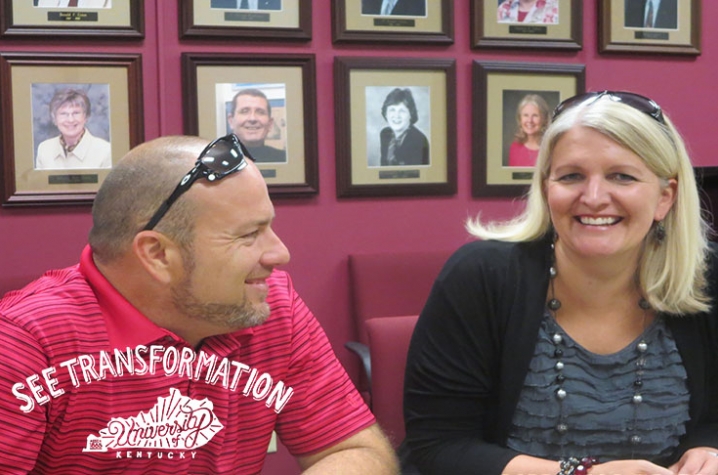'Wake-Up Call' at 36 Prompts Life Transformation

LEXINGTON, Ky. (Oct. 10, 2014) — A fast-food combo meal, plus an extra sandwich and two extra-large sweet teas.
That was lunch.
“I’d only have that if I skipped breakfast,” Jarrett Spriggs said. ”But dinner was always meat and potatoes, no vegetables, and between meals there were (snacks and sugary drinks) and entire full-size bags of chips.”
Add to that a pack-a-day cigarette habit, and you have a recipe for disaster.
Spriggs had just finished a normal work week in May when he was awakened by terrible chest pains early Saturday morning.
“I knew something was really wrong when the pain moved from my chest to my left arm,” Spriggs said, referring to the heart attack guidelines found on many websites and other patient literature. But Spriggs was just 36. Even as they called 911 for assistance, he and his wife Amy thought this would be only a case of “expensive heartburn.”
In fact, Spriggs was experiencing a deadly condition, called an ascending aortic hematoma, that occurs when a tear develops in the inner wall of the aorta, the main artery that carries blood from the heart. The tear causes blood to flow between the layers, forcing them apart.
Spriggs' condition was a rare type of what is known generally as an aortic dissection, a dire medical emergency. In many cases, patients bleed to death before they can reach a hospital. Many people associate the condition with actor John Ritter, who succumbed to an aortic dissection in 2003.
Spriggs was whisked into a 5-1/2 hour surgery, in which cardiothoracic surgeon Dr. Hassan Reda replaced a portion of Spriggs’s diseased aorta with a tube made of cloth.
“Jarrett is a very lucky man, because the mortality rate for an aortic dissection is 50 percent, and the variant Jarrett experienced is pretty rare,” Reda said. “He acted quickly to get help, and he got to the right place.”
Amy Spriggs remembers being in a state of denial as her husband was diagnosed and prepped for surgery.
“I think I just shut down as a form of self-preservation,” she said. ”I was telling friends, ‘Oh, they’ve put him on [heart-lung] bypass,’ but it never really sank in that, hey, my husband is dangerously sick. My first inkling that this could be serious was when Dr. Reda suggested I bring our daughter Kennedy to see Jarrett before he went into surgery. But it wasn’t until after Jarrett came out of surgery that I broke down crying.”
What brought Amy to tears was Spriggs’s prognosis. Dr. Reda told Amy that Spriggs had the heart tissue of an 80-year-old man. Without some drastic changes, he likely would not live to see his 50th birthday.
So, once Spriggs left the hospital, he quit smoking.
He found phone apps that help him measure the dietary values of restaurant foods and track his exercise and calorie intake.
He lost almost 50 pounds in five months.
He went back to work just six weeks after his surgery.
The entire family leapt on the bandwagon. Amy was a one-woman army, researching heart-healthy recipes and meal planning. And 10-year old Kennedy served as her father’s conscience.
“If she sees me near something I shouldn’t eat, she tells me, ‘That’s not heart-healthy, Daddy,’” Spriggs said, laughing.
Starting in December, cardiac patients like Spriggs will recuperate in the new cardiovascular unit on the 8th floor of Pavilion A. The 64-bed unit will incorporate many elements of the old unit in the UK Chandler Hospital with new features designed to maximize patient recovery.
There will be a guided walking path within the unit that patients and visitors alike can use. Research demonstrates that when patients begin exercising in the hospital they are more likely to continue that activity at home.
A multidisciplinary team of nurses, physical therapists, and UK exercise science students (fondly called “Catwalkers”) will walk almost every patient in the unit at least once a day — again, encouraging active patient involvement and self-care post-discharge.
One crown jewel of the new unit is a state-of-the-art interactive TV system in every patient room, funded by the Don and Cathy Jacobs Charitable Foundation. It provides patients with information and educational materials about their diagnosis, their care team, and their treatment plan. Even better: the patient can access the same information from their home computers — a real bonus in considering how difficult it is to remember instructions when you are sick, sleep deprived, or stressed out.
It’s all part of the “culture of activity and education” that Dr. Alison Bailey, director of preventive and ambulatory cardiology and cardiac rehab at the Gill Heart Institute, promotes on behalf of patients like Spriggs.
“Cardiovascular disease, smoking, obesity and physical inactivity are the modern plagues of our society,” Bailey said. “The good news is that these are almost always reversible diseases that can be treated, if not cured. The goal of cardiovascular rehabilitation is to help patients shift back into a healthy lifestyle in a safe, fun environment.”
Spriggs says considers his episode a “wake-up call from God,” and he’s committed to doing everything in his power to make good on this second chance.
“For the longest time one of my main objectives, dreams, goals, since I had my daughter, was walking her down the aisle,” Spriggs said.
“I decided at that point that I am going to change. It came down to a ‘Will it kill me, or will it not kill me?’ attitude. So I do whatever I can now to make sure I’m there whenever that day comes.”




